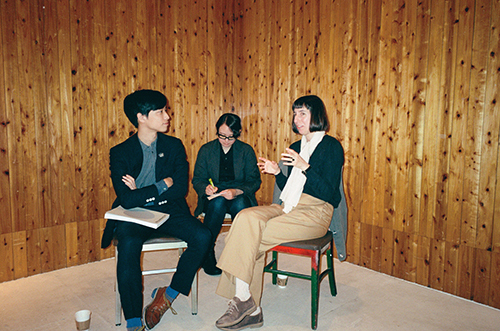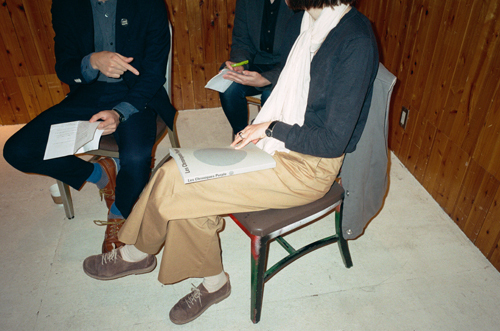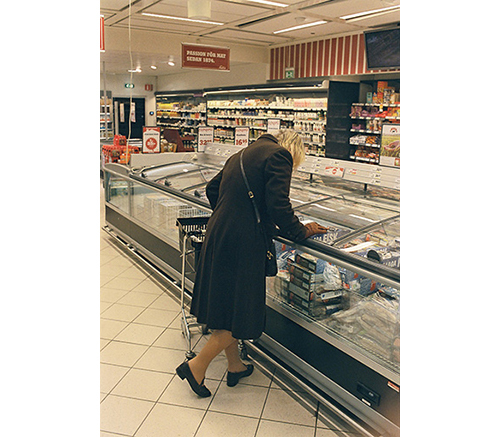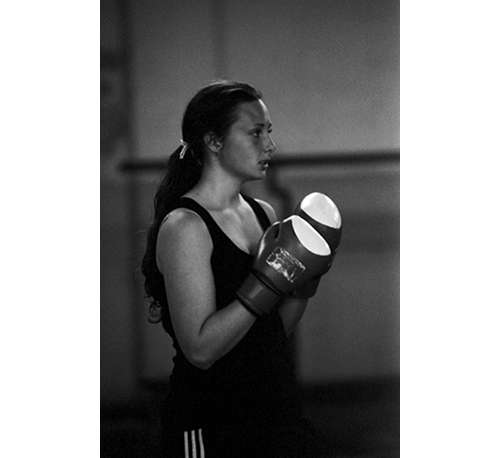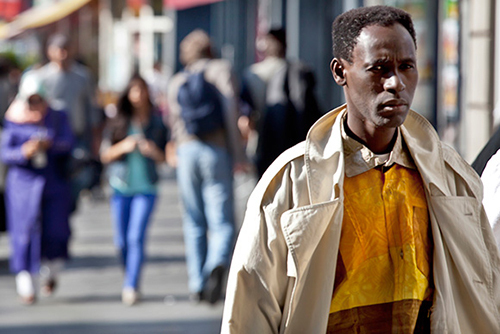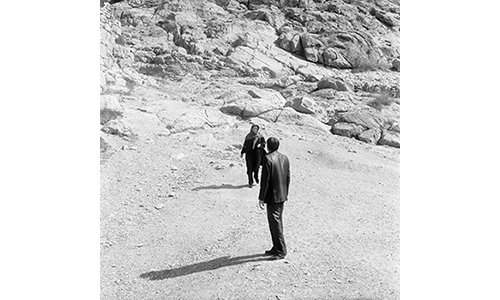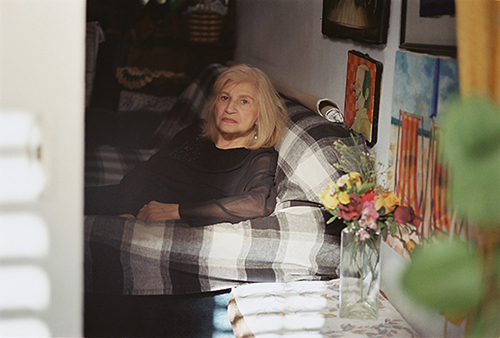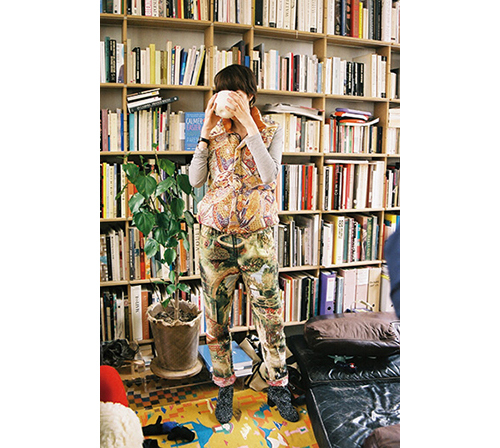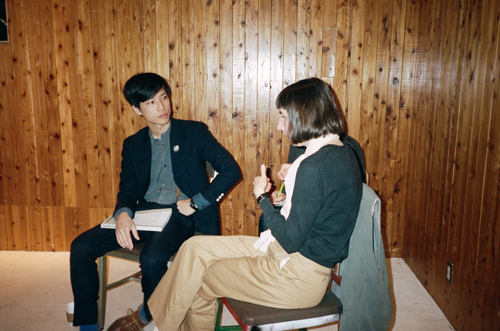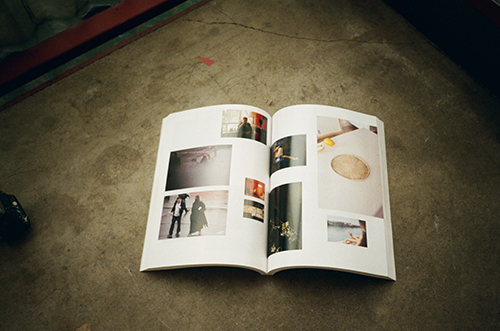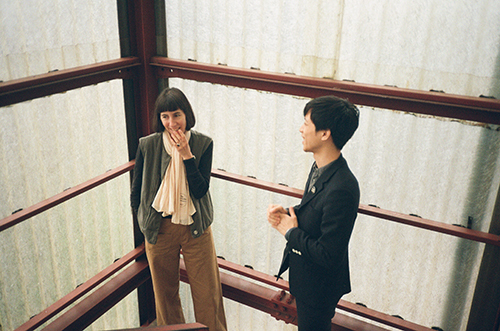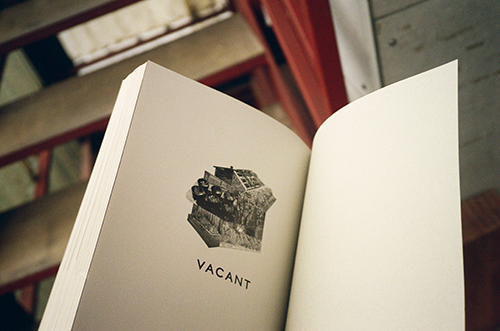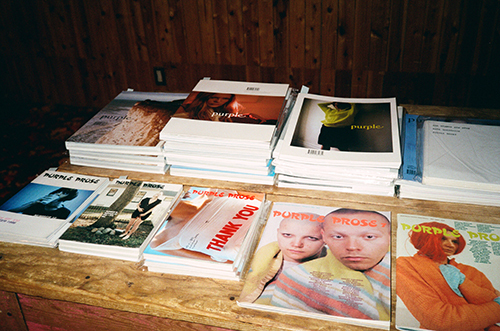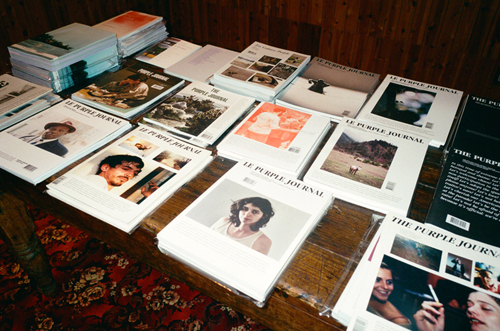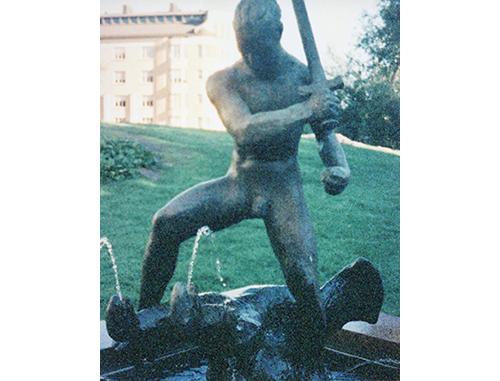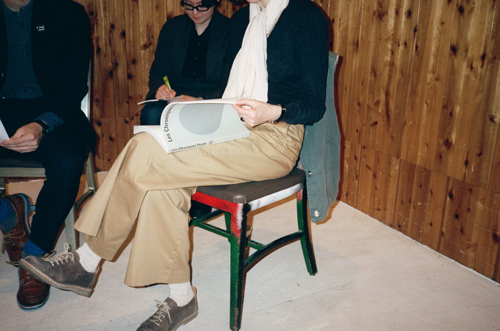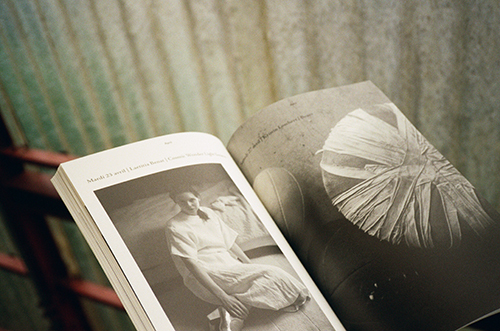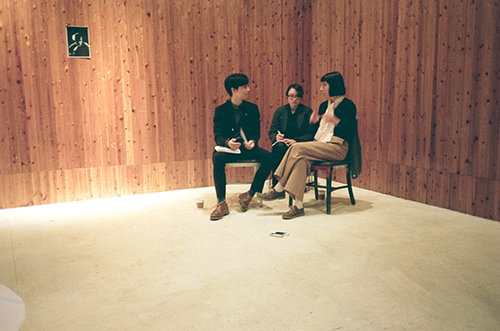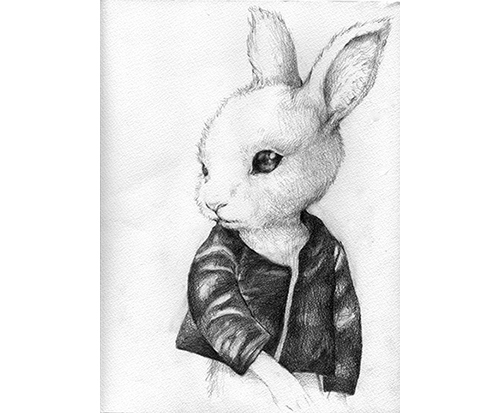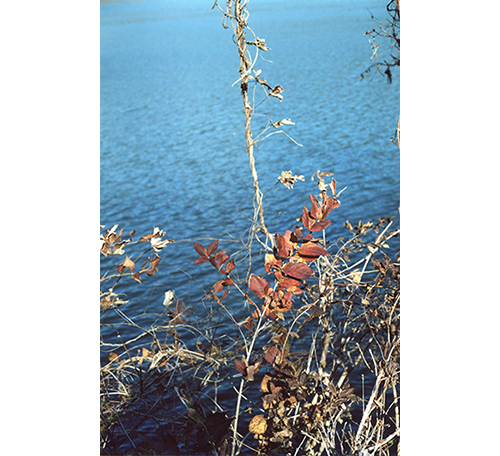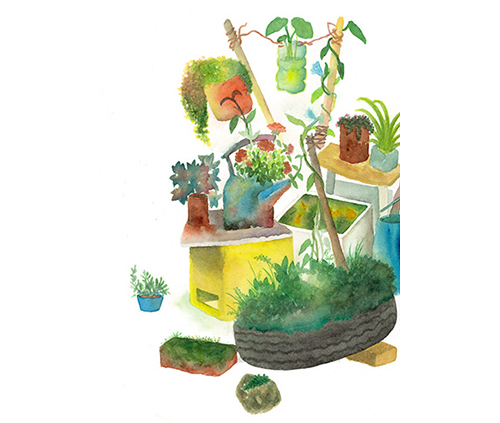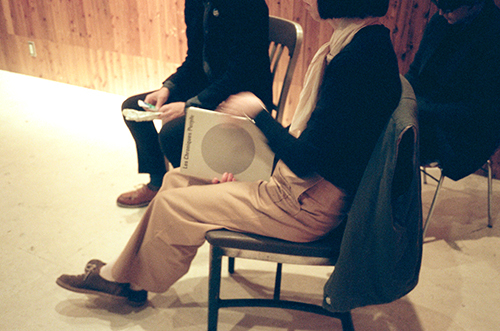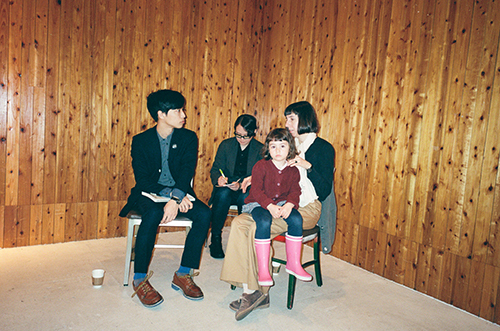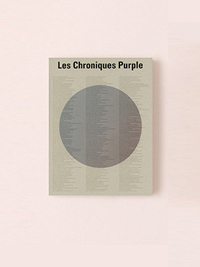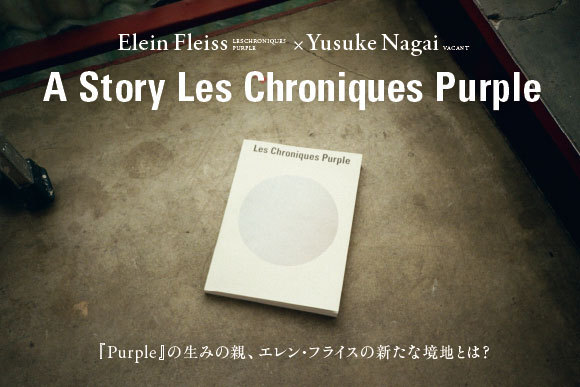
アートとファッションの新たな関係性を築いた雑誌『Purple』。その創刊者であり、才能あるアーティストのネットワークと、古びることのない良質な美意識を息づかせたのが編集者であるエレン・フライスです。この度、彼女にとって4年ぶりの書籍が出版されました。一つのシーンを作り上げた彼女のクリエイティビティは今どこに向かっているのでしょうか。国内外の上質なアートとカルチャーが行き交うスペース「VACANT(バカント)」のオーナーであり、この度一緒に出版を行うことになった永井祐介さんに、本のことや今の心境についてなどのお話を伺ってもらいました。
Photo_Rie Suzuki
Interpreter_Kei Benger
Edit_Kanae Yamada
エレン・フライス(レ クロニーク パープル)
1992年にインディペンデント雑誌の先駆けである『パープル プローズ(Purple Prose)』を刊行し、以降『パープル』、『エレン(Hélène)』、『パープル ジャーナル(The Purple Journal)』など、アートとファッションを中心とした個人出版の雑誌をつくり続けてきた編集者。2013年元旦に始めたWebサイト『レ クロニーク パープル(Les Chroniques Purple)』をまとめた書籍をこの度出版。
Elein Fleiss(Les Chroniques Purple)
In 1992, Elein Fleiss co-published Purple Prose that set a precedent for independent magazines. Since then, she has continued to publish independent magazines centering on art and fashion, such as Purple, Hélène, and The Purple Journal. This time she published a book that brings together articles from the Web site Les Chroniques Purple which began on New Year's Day in 2013.
永井祐介(NO IDEA/VACANT)
1985年東京生まれ。原宿にあるフリースペース「VACANT」主宰。
09年写真集『varnish and mortar』(リトルモア)を出版。同年、フリースペース「VACANT」を立ち上げる。
Yusuke Nagai (NO IDEA/VACANT)
Born 1985 in Tokyo. Oversees the Free space VACANT, located in Harajuku . In 2009 Nagai was awarded the Grand Prize for his publication "varnish and motar" (little more books) at the '1st little more BCCKS public competition for photo books.' In the same year, he launched the free space VACANT.
VACANT永井祐介氏(以下敬称略/永井): まずはこの展覧会を行うことになった経緯から話し始めましょうか。
VACANT Yusuke Nagai (Nagai): Could you tell us about how you came to work on this exhibition?
Les Chroniques Purple 編集長エレン・フライス(以下敬称略/エレン): それはやっぱり、永井さんに声を掛けてもらったからですね。
Les Chroniques Purple Chief Editor Elein Fleiss (Elein): Well, firstly because I was invited by you.
永井: ウェブサイトを作るところから始められたんですよね?
Nagai: Well first you started your website right?
エレン: そうです。まず私がパリを離れたときにさかのぼってお話したほうがいいかもしれませんね。全てはそこからスタートしているので。パリを離れるということは、慣れ親しんだ環境、一緒に仕事をしていた仲間や友人達から離れ、新しい場所でひとりの生活を送ることを意味していました。今回のプロジェクトは、ある意味それが関係していると思います。
Elein: Yes. Perhaps I should go back and talk about when I left Paris, because it all started there. This project in a way is linked to that because since leaving Paris I was no longer with my surroundings such as my work and work partners. I was alone in a new place.
永井: レティシア(パリを拠点に写真、ドローイング、陶芸、映像など幅広い分野で活躍するアーティスト。『パープル』、『パープル ジャーナル』でクリエイションを行う)も一緒に移住されたんですか?
Nagai: Laetitia (An artist in various fields including photography, drawing, pottery, based in Paris. Worked on the creative art direction for Purple and Purple journal.) moved to a new place too?
エレン: いいえ。私ひとりでの移住でした。彼らはみんなパリに残り、私のみが離れることになりました。もちろん仲間と仕事をするのは好きだったのですが、私はどうやって個人で雑誌の出版を続けていくかという方法を探していました。同時に、そのとき私はいくつかの課題に直面していました。例をあげると、自分自身が前に比べ、より孤独な環境にいたということです。私はパリを去ってから1日も戻ったことはありません。もうかれこれ6年パリへ行っていないですね。
Elein: No, only me. They all stayed in Paris and I was the only one who left. I was wondering about how to continue my work and keep publishing a magazine without being with them. Not that I didn't enjoy working with them of course. I was also facing several concerns at that point. For instance, there was the fact that I was more isolated. Since I left Paris I never went back; not even for one day. I haven't seen Paris in nearly 6 years now.
私はアートやファッションの業界に身を置かなくても、資金を集める方法を探さなくてはなりませんでした。ファッションショーへ行かなくなると業界関係者に会う機会もなくなります。私は業界の「駆け引き」に参加したくなかったので、(雑誌の)広告主も自ずと減ってしまいました。資金の問題は常にありましたね。まぁ、何かしらの企画に携わる人にとって資金集めは悩みの種だと思いますが、中にはこの「駆け引き」を素直に応じる人もいます。でも私にはそれができない。前にオリヴィエ(ザーム)(現在の『パープル ファッション マガジン(Purple Fashion Magazine)』編集長。エレンと一緒に『パープル プローズ』を創刊した)と仕事をしていたときは、彼がこのやり取りを全て受け持ってくれました。ただ、お互いに違う道に進むと決めたとき、私は広告に関して、有名ブランドと手を組みたいとは思いませんでした。なぜかって? それは、彼らがいつも何かしらの交換条件を出してくるからです。
Then there was also this issue of how to find funding without being in an art or fashion context. When you don't go to fashion shows you don't see the particular people of the industry, therefore my advertisers were becoming more reduced because I never wanted to play that 'game.' Money was always a problem for me. I mean, it is a problem for everybody but some people go along and play the 'game.' I myself have a hard time playing it. When I was working with Olivier (Zahm) (Current Purple Fashion Magazine editor in Chief. Founder of Purple Prose with Elein) he was in charge of this, but when I decided to pursue my own path I did not want to have advertisements from big brands because they always ask you for something in exchange.
そこで私は、広告関係の仕事をしている知り合いの女の子に相談しました。彼女に『パープル ジャーナル』と『Les Cahiers Purple(レ カイエ パープル)』のスポンサー探しを手伝ってくれるよう頼んだのですが、彼女は色々と複雑な提案をしてきて、私はそれを受け入れることができませんでした。好きではない服やブランドの写真は撮りたくなく、本当に興味のあるものだけを選んでいましたね。そんなことをしていたので、可能性や選択肢はぐっと減っていきました。最終的には5つか6つほどの広告スポンサーしか選択肢が残らなかったんです。さらに私の場合、パリを遠く離れて、2年間ポルトガルで生活をしていたので、好きなブランドの作品すら見る機会もありませんでした。私は協力を仰ぎたくなく、当時は資金もまともに持っておらずで、ひとりの生活を送る日々が続いていました。
At first I asked a girl who was working in advertising to try and find advertisers for Purple Journal and Les Cahiers Purple, however she started to propose some strange things concerning what measures we would have to take. These were all impossible for me. I did not want to take pictures of clothes and brands I did not particularly like, which minimizes possibilities a lot since it essentially reduces options to only a few brands by people who's work you are really interested in. So in the end, there were only five or six advertisers left. Furthermore when you leave Paris and live far away in Portugal where I lived for three years, or in the country, you don't even get the opportunity to see the brands you like anymore. I didn't really feel like asking anyone for funding, so I was in a situation where there was no money and I was living far away.
私は長い間悩み、何をするべきかを考えました。手元にはいくらかの資金が残っていたので、はじめにアーティストブックを限定エディションで出版することを考えました。でも、色々と想いを巡らせていくうちに、自分が本当に好きなことは何なのかに気づきました。結局、いろんな人の作品を一つの本にまとめるという結論に行き着いたんです。そうして私はすぐインターネットの可能性を考えました。まあ、常にネットをひとつの選択肢として視野には入れていたんですが、私はことあるごとにその可能性を否認していました。ウェブから発信することに一種の抵抗があったんです。ウェブマガジンの取材でこんなことを言うのも何ですが(笑)。私は世代が違う人間なんです。今年で46歳ですが、ネットを使って発信することは、私にとってとても難しい決断でした。もちろん、ネットで新聞や記事を読んだりすることもありますが(今の新聞は面白くないですね)、それはあくまでも生活の一部ではなかったんです。(出版)方法はインターネットしか残っていないことを重々承知していたんですが、ここ何年間にわたる葛藤の中で常にそれを否定してきました。
I waited for a long time and thought about what I was going to do. I first thought of publishing artist books in small editions since I had a little bit of money left, but then I realized that what I really love is bringing people together in one publication. I thought about the Internet right away. Despite continuing to think about this option , I at the same time kept telling myself that it was not a possibility, and that it would be a terrible way to publish. Perhaps I shouldn't say this during an interview for a web magazine! (laughs). But no, I am just from a different generation. You have to remember that I am 46 years old so for me it was a very tough decision to make. The Internet wasn't something that was really a part of my life, even though I do look at some stuff on the Internet like the newspaper (I don't like the newspaper anymore). I knew that the Internet was the only way (to publish) and I kept thinking about it over the past several years. However, I would just say to myself that I could not do it.
永井: なるほど。
Nagai: I see.
エレン: 私を含め、周りの人たちはみんな印刷物が好きでした。純粋に紙とインクが好きだったのです。けれども新たな方法を考えつかないまま、それでも何かを出版したいという思いは徐々に強くなっていきました。そして結局最後にはインターネットを使うことに決めました。このことを友人たちに相談するのは、いくらか恥ずかしかったですし、数十年を経て有名になった雑誌の発案者が、一からブログを始めるというのも少し不思議な気持ちでしたが、一旦決心すると、私はすぐに行動を開始しました。この決断に対しては誰も批判する人はいませんでしたね。みんな、私がまた何かを始めたことに対して喜んでくれたんだと思います。これは私の励みになりました。
Elein: Also, all the people around me really liked printing. It was not only myself, but everyone around me who liked to print with ink on paper. It's nothing luxurious as you know, but still nonetheless. However despite my concerns the desire to do something became stronger, so after a while I decided to go ahead with it. It's true that I was being a little shy to ask all my friends, even Laetitia. It is also strange for someone who's published a magazine that became famous over the years to suddenly start a blog. When I finally made my decision, I acted on it. In fact, nobody was being negative about this. I think they were happy that I was doing something again. This in a way comforted me.
そして奇跡が起こりました。永井さんが今回の展覧会の企画及び、記事を(全てではないですが)ひとつの本として出版するチャンスをくれたんです。今回のプロジェクトに携わって、私はある意味自動的に機能する「機械」(マシン)を作り上げたことに気づいたんです。それは私にとってひとつの課題となり、このプロジェクトが1年間という限定されたスパンの中で行われたことに基づいています。私は全ての作家、アーティスト、写真家に毎月ひとつのコラムを投稿してもらう提案をしました。これは私が課した唯一の条件でした。そのときはこんなお願いをしただけで、後で作品や文章に対して「先月のコラムがあまり面白くなかったから、テーマを変えてくれ」などとは言いませんでした。なぜなら、それはもちろん彼らにとって大変な負担になるからです。なので、ときには予想外の投稿もありました。この本を通して、最終的に自分が一番好きな編集の仕事に携わることができて嬉しかったですね。
Then a miracle happened because Yusuke invited us to do this exhibition and to print not all the chroniques, but a good portion of them. One of the problems with my project, which is also the reason why I only worked on it for a year, is that towards the end I realized that I had started a kind of 'machine' that was working by itself. What I asked every writer, artist, or photographer to do was to contribute a monthly chronicle, which was our agreement. Once this agreement was made, I didn't take the freedom to say for instance, "I didn't like your last chronicle so perhaps you should change the theme." I couldn't do that because it would be a lot of work for them. Therefore there were some instances when the outcome was not as anticipated. However, It was great to finally be able to select and do my editorial work, which is what I really enjoy doing.
永井: プロジェクトに参加する著者はどのように選ばれたんですか?
Nagai: How did you choose the writers for the project?
エレン: まずは以前にも『パープル ジャーナル』や『レ カイエ パープル』に参加してもらっていたアンダース(スウェーデン出身。『Purple』の創刊に関わり、彼らの重要な部分を占める写真家として活躍。ファッションデザイナー・マルタン・マルジェラとのコラボレーションなど幅広い活動を続けている)、レティシア、ガエルといった、親しい人たちに声を掛けました。ただ、毎日記事を投稿するには最低でも30人の参加者が必要だったので、今回のプロジェクトではより多くの人たちに声を掛けないといけませんでした。また、「月一でコラムを執筆する」という形式が難しい人もいたので、たとえそれが個人的にとても興味がある人であっても、全員に参加をお願いすることは叶いませんでした。
Elein: Well, first it was mainly people from my usual group like Anders (Born in Sweden. Contributed to "Purple" from its first issue, and has since been one of their most featured and influential photographers. Including his collaboration with fashion designer Martin Margiela, Edström has continued to work extensively in a wide range of areas.) and Laetitia, and even writers like Gaelle who had all been initial participants of Purple Journal and Les Cahiers Purple. That was how it had begun but it was not enough for the project because in order to publish daily I needed to have at least 30 people contribute. Also, not everybody fitted into this 'monthly' format. I could not ask everyone to be part of it even though there were some people who I really liked.
ユン・キットのように、中にはとても面白い出会いもありました。私は彼が執筆したマレーシアに関するコラムをすごく気に入っています。彼を見つけた経緯はとても不思議です。私のパートナーのギオームは時々ネットにアクセスしては、私の出版した雑誌に関する記事や情報がアップされていないかを検索していました(私は自分で率先して探すことはないんですが)。そこで彼は、『レ カイエ パープル』といくつかのオブジェをともに写した一枚の写真を掲載したサイトを見つけたんです。それはマレーシア人の男性によって撮影されたもので、写真には短いコメントが添えられていました。サイトには何の連絡先も書かれていなかったので、当初は直接コンタクトを取れませんでした。調べていくうちに名前とメールアドレスを見つけ、彼に連絡を取ることができました。彼は私からの連絡がきて驚いている様子でしたね。
Then there were some strange encounters like the way in which I met Jun Kit. I really like his chronicle about Malaysia. In fact I found him in an interesting way. My boyfriend Guillaume sometimes looks on the Internet to see if people are talking about my magazine (I never do that myself) but he found this guy in Malaysia who photographed this really nice picture of Les Cahiers Purple and some objects together in a room. There was also a little comment that accompanied the piece. I had a really hard time finding him because there were no contact details, but in the end after some research I was able to find his name and his email. He was completely surprised that I contacted him.
永井: そうだったんですね。では、彼は自身のサイトで(雑誌にまつわる)投稿をされていたんですね?
Nagai: I see. So he had done something (about Purple) on his website?
エレン: はい。彼はマレーシア出身の写真家兼グラフィックデザイナーでした。彼の一連の投稿は一つのコラムとして「上手く成立」していると思います。私は彼の作品がとても好きです。このような感じで、何人かはインターネットを通じて知り合いました。インターネットを使うことはマイナスばかりではなかったんです。なぜなら、tumbler(タンブラー)を通じてクリスティーンとの出会いもあったので。彼女と出会えたことも、とても嬉しかったですね。
Elein: Yes. He was a photographer and graphic designer from Malaysia. I think what he did really 'worked' as a chronicle. I really liked his work. So yes, I did find some people through the Internet. It wasn't all that bad to do things on the Internet because this also led me to start looking at tumblr. I discovered Kristin through this. In fact I was happy to find her.
エレン: 雑誌に掲載する写真に至っては、いつもレティシアとチームを組んで作業をしています。私たちはホンマ・タカシさんの写真のほかにも、以前一緒に仕事をしていた人や、自分たちの好きな人の写真を見ていたんですが、何年か見ないうちに非常にコマーシャルなものへと変わってしまいました。彼らのポートフォリオはどれも同じに見え、私は心なしかショックを受けました。「何が起こってしまったのだろう? どの写真も同じに見えてしまう」と内心密かに思いましたね。だから一層、クリスティーンの作品と出会えたことが嬉しかったです。
Elein: In terms of photography I always work with Laetitia and I always work as a team. We looked at works by photographers who we usually used to work with besides Takashi Homma and others whom I still really like, but somehow or another within the few years that I hadn't seen their work, some of them had become very commercial. I looked at their portfolios and I just thought that they all look the same. I was a bit shocked. I thought to myself, "what is happening with photography? It all looks the same." Therefore I was happy to come across Kristin's work.
そしてもちろん、ギエルモ・ウエノを始めとしたアルゼンチンのネットワークもあります。彼には一度も直接会ったことはないんですが、長い間一緒に仕事をしています。ギエルモは日本からアルゼンチンに移り住んだ移民の子孫なんです。
Then of course there is the Argentinian network that is all centered around Guillermo Ueno, who I had already worked with for a very long time despite having never met him. He is a descendent of Japanese immigrants who had settled in Argentina.
永井: 僕はオリヴィエ・カヴァーンの写真もすごく好きです。
Nagai: I loved Olivier Kervern's photos too.
エレン: 彼とは以前からの知り合いでした。私も彼の作品はすごく好きです。どちらかというと、ファッションの枠を超えたクラシカルな写真家ですね。彼は作家である私の友達の友人なんです。彼とはそういう経緯で知り合いました。そうそう、ギエルモ・ウエノの話をしていましたね。ギエルモの周りにはさらにたくさんの写真家の知り合いがいて、彼はそこ(ブエノスアイレス)でオルタナティブ・スペースを運営し、さまざまな面白いプロジェクトに携わっています。
Elein: Yes, I already knew him from before. I like him too. He has no link with the fashion world, and is more of a classical photographer. He is a friend of a friend who is a writer. That is how I met him. So yes, I was talking about Guillermo Ueno who is a photographer from Buenos Aires. He has a lot of other photographers around him as well. He also has an alternative space there (in Buenos Aires) where he partakes in many interesting projects.
永井: 企画をまとめていくに当たって、写真やテキストの間で何かしらのバランスを意識していましたか? 著者達がどのような作品を投稿するかは前もって分かってはいなかったんですよね?
Nagai: So did you think about a balance concerning the chronicles such as between the photographs and texts? You had no idea what the contributors would do?
エレン: 特定のテーマに沿って投稿してもらうよう、場合によっては相談することもありました。たとえば、アミット・バーロウィッツのコラムは私からアイディアを提案させてもらいました。ケースバイケースですね。ホンマ・タカシさんのときは私から一つのテーマを提案したんですが、そのアイディアがあまり面白くなかったのか、彼はさほど興味を示してくれませんでした。当初は工芸といった、手仕事をする人たちのポートレートを撮影する予定だったんですが、彼はそのアイディアに魅力を感じなかったみたいです。最初だけ私が提案した路線で進めて、途中でテーマを変えてしまいました。私自身、それがとても嬉しかったんですけど(笑)。
Elein: Most of the time I discussed with the contributors and asked them for a specific theme. For example I had made a proposal myself with regards to Amit Berlowitz I suppose it depends on the case. On the other hand for Takashi Homma I had first asked him to work on a precise theme, however my idea perhaps was not that good since I don't think he was too interested in it. I initially had asked him to make portraits of people working with their hands such as craft etc. but I don't think he was taken by that idea. He worked on it for a while, but then he ended up changing it. I loved his new chronicle, Fiction Story, so it was good that he made the change. (laughs).
こっちからアイディアを提案することはあったんですが、全ては状況によりけりでした。私はマレーシアを訪れたことがなかったので、ユン・キットの場合は彼のコラムを通して母国を案内してくれるようお願いしました。それはガイドブックや新聞で読むような記事ではなく、彼個人の視点から見たマレーシアに興味がありました。私的な文章であって欲しかったんです。また、新しく暮らし始めた村で出会った人たちにも今回のプロジェクトに参加してもらいたいという気持ちがありました。村で知り合ったセリア・イゾアールとアルティア・サン・アマンドのコラムは上手く成立させることができましたね。他にも2名ほど村からの参加してもらったんですが、連載が続かなかったので今回は載せていません。中には本や雑誌に文章を掲載したことのない人たちに執筆をお願いしました。これは特に面白い結果を生んだと思いますね。
So yes, sometimes I did present my ideas to them, but it really depended on the case. With Jun Kit I had told him that I did not know anything about Malaysia, and thus wanted him to make me visit it through his chronicles. I wanted him to give me a subjective idea, and not something that you would read in a guide or a newspaper. I wanted something more personal. I also wanted to include some of the people living in my new village in the region where I currently live. Two persons I met, Celia Izoard and Althea Saint Amand, worked really well in this context. There were also two others whom we didn't include in the book because it (the chronicle) wasn't continued. Sometimes I had asked people who had never specifically written texts for books and magazines before to write, and this especially had interesting results.
永井: ところで、キタオリ・アサコさんはどんな方ですか?
Nagai: By the way, who is Asako Kitaori ?
エレン: アサコさんですね。実は彼女には面白い話があって。大類信さん(『ロッキング・オン(rockin'on)』『パープル』のADを手がけたエディトリアルデザイナー。今回のプロジェクトの企画協力としても参加)は彼女とはずいぶん昔からの知り合いのようですが、アサコさんは当時ニューヨークに住んでいて、(今回のプロジェクトに参加してもらった)スティーブン・スプロットの友人でした。私が地方での生活についてスティーブンと話をしていたとき、彼はパートナーと一緒にニューヨークから日本へと帰国した友人について教えてくれました。彼女たちは今、舗装道路からも遠く離れた地方の山奥に暮らしています。家までの道のりは遠く、周りに何もありません。彼女たちは自然の中で食料を集めたり、野菜を栽培したり、自らのライフスタイルを考案するワークショップを開催しながら生活をしています。彼女たちのブログがあるのですが、これが面白いんです。私もよく自然の中でハーブを摘みますが、ニューヨークのような都会から自然へと移住した彼女のライフスタイルには不思議と共通点を感じました。
Elein: Ah yes, Asako. She has an interesting story in fact. Makoto Orui(editorial designer for rockin'on, who worked on the AD for Purple. Participated as the art director for this time's Purple exhibition.) has known her for a really long time. She used to live in New York, and she is also a friend of Stephen Sprott. In fact when I told Stephen about my experience living in the countryside, he told me about this friend who used to live in New York who later came back to Japan with her boyfriend. They live in the mountains now, even very far from the road. They have to walk a long way to their house, where they live in a completely remote setting. They live out of foraging and growing vegetables, and they do workshops to teach others about this way of living. They also do a blog, which I really like. It is funny because I was picking some herbs in the countryside (which I do quite a lot), and to find out about this woman who also went from New York and the to the country, I felt a strange parallel between my lifestyle and hers.
永井: ある意味、日々サバイバルのような生活を送っているんですかね。
Nagai: So in a sense, everyday is a matter of survival for you?
エレン: そうですね。彼女達は私よりはだいぶストイックです。私は火の起こし方も知りませんし、スーパーへ買い物にも出かけます(笑)。
Elein: Yes, kind of. I must say, they are much more radical than we are though. I don't know how to light a fire, and I also go to the supermarket (laughs).
永井: アサコさんとは直接お会いしたことはないんですか?
Nagai: You've never met Asako?
エレン: ええ。会ったことはないです。スティーブンが彼女を紹介してくれたんですが、その後から彼女がガエル・オビエグリーや大類さんとも知り合いであったことを知りました。不思議でしたね。
Elein: No. It was really strange because Stephen introduced me to her, but she said that she also knows Gaelle Obiegly. Then she also said she knows Makoto.
永井: 彼女は京都に住んでいるのでしょうか?
Nagai: Does she live in Kyoto?
エレン: どうでしょう。人里離れた場所で生活してらっしゃるので、京都ではないとは思うんですが、そんなに遠くではないのかもしれないです。彼女は自分が住んでいる場所が東京から電車で3時間の場所にあると教えてくれました。京都ではなく、日本北部の方かもしれないですね。ブログには書いていないので、具体的には分からないです。
Elein: Maybe. I don't think it's Kyoto as it is much more of a remote place, but perhaps it is not too far from Kyoto. Actually, she said it is three hours from Tokyo. Perhaps it's not Kyoto but is somewhere in the North. I can't tell from the blog, as they don't mention where exactly.
永井: 書籍の中で一番好きなところはどのページですか?
Nagai: Which is your most favorite page out of the publication?
エレン: 今回出版した本からということかしら? それは難しい質問ですね。内容? それともレイアウトやビジュアルに関して?
Elein: Do you mean from this book? Now that is difficult. Do you mean in terms of content, or in terms of layout and visuals?
永井: どちらでも。
Nagai: Either way.
エレン: すごく気に入っているテキストはいくつかあるんですが、それらにはビジュアル的な要素はなく、文章そのものといった感じです。
Elein: Because there are some texts I really love, but it is simply a text without visuals.
永井: 本を始めてご覧になったとき、色味が気に入っていると言っていましたよね。
Nagai: When you saw this book for the first time, you said you loved the colors.
エレン: ええ。それは全体がモノクロでないことに対して言ったことでもあったのですが。そうですね。カラーページがとても気に入っているので、あえて選ぶとすれば、真ん中の見開き部分が一番好きです。お気に入りの文章を一つ選ぶのは難しいですね。
Elein: Yes. Well that is also because there is a lot of black and white. I really like the color pages, so perhaps I like the middle section of the book the most, visually speaking. Otherwise it is a bit difficult to choose a favorite text.
永井: 車の中で、「本を初めてみたとき、まるでパラレルワールドで作られたかと思った」とおっしゃっていたのが印象的でした。
Nagai: It was interesting when we were in the car and you said that, "it feels like it was made by us in a parallel world.'
エレン: 覚えています。私はいつもレティシアと一緒に『パープル ジャーナル』のレイアウトを組んでいましたが、当時『パープル』のアートディレクターをしていたクリストフにもよく相談をしました。彼は表紙のみ担当していましたが、私たちはデザインの専門家でなかったので、彼に私たちの作ったレイアウトを見せては、その都度意見を聞いていました。今回本のPDFをレティシアに送ったとき、彼女は「自分たちが作った本のようだ」と言っていましたね。それは親しみを感じるものであるのと同時に、実際に彼女が手がけたものではないので、パラレルワールドで作られたかのようだと言っていました。私も最初は新しいデザイナーと仕事をするのに多少慣れない部分はあったのですが、彼の仕事を見せてもらったときに、よい決断であったと確信しました。彼の美意識やセンスは私にとても近いものがあったからです。だからこそ、永井さんが今回このデザイナーさんにお願いされたと思うんですが。
Elein: Yes, I remember this. I usually work with Laetitia on the layout for Purple Journal. Sometimes we would ask Christophe who used to be the art director for Purple, but he only does the cover as well as reviews our work since we are not professionals in this field. I sent the PDF of this book to Laetitia, and she said that it looks like something that we did but in a parallel life, because it is very familiar but we didn't do it. It was rather strange at first to work with a new designer, but when I saw the work he had done I thought it was a good choice as he had a similar aesthetic sense. I suppose that is the reason why you had chosen him.
エレン: 個人的に興味深いと思ったことがあります。ウェブサイトを立ち上げてから書籍化へ向けて作業し、今ようやく『レ クロニーク パープル(Les Chroniques Purple)』という一つの本として出版されたわけですが、そう思うと、今までネットで行って来たことはある種のワーク・イン・プログレスだったと思っています。それは、パソコン上で雑誌に掲載するテキストや画像を集める作業に似ています。今振り返ってみると、ウェブサイトは一年かけて行われたワーク・イン・プログレスであり、それが最終的にこのような本に変化したんだと考えています。これも、永井さんのサポートがあったからです。最初から(書籍化や展覧会を)視野に入れてなかったわけではないですが、当時の私にはこれらを実現させる方法が思いつきませんでした。私にとってこの本こそが『レ クロニーク パープル』なのです。サイトはここに行き着くまでの過程に過ぎないですね。
Elein: What's interesting about working on the site and then the book is that because this book has now finally been published as "Les Chroniques Purple," I have come to consider the site more as a work in progress. It's similar to making a magazine, such as the way in which you gather all the texts and images on a computer. Therefore I see this now as a work in progress that took place over the course of one year, which then transferred into this book. Again, this is thanks to you of course. It's not that I didn't plan this (publication and exhibition) to begin with, but I did not know how to make it happen in such a way. So for me, "Les Chroniques Purple" is now this book. The site is just the progression until this point.
永井: 話は変わりますが、このスペース(VACANT)のことはどう思っていますか?
Nagai: On a different note, what do you think about this space (VACANT)?
エレン: 素敵なスペースだと思います。ご縁があって嬉しかったです。以前〈ズッカ(Zucca)〉や「「ポエトリー・オブ・セックス(Poetry of Sex)/トゥリーズ・アー・ソウ・スペシャル(Trees are so special)」でコラボしたことがあるので代官山や表参道は知っていましたが、このエリア(原宿)はあまり詳しくないです。でも、ここのオフィスの雰囲気はすごく好きです。フランスにはこのような、カフェ、書店、オフィス、出版社、ギャラリーといった全ての要素を一つに融合したスペースはないですね。
Elein: I think it is a nice space, and I was happy to discover it. I'm not that familiar with this area, as I know more about places like Daikanyama and Omotesando because I did something before in the Zucca store or with Poetry of Sex/Trees are so special. I really like the spirit in your office though. Actually, we don't have this kind of space in France, that has a cafe, bookstore, office, publishing house, and gallery all merged into one. It doesn't really exist.
昨日オフィスにお邪魔させていただいた際、働いている皆さんの姿を眺めていたんですが、私たちが「パープル インスティチュート(Purple Institute)」を運営していたときと似たような印象を感じました。私たちは以前大きなオフィスを持っていました。そこはとても広いスペースで、元は印刷所として使われていた建物でしたね。店舗が隣接していて、私はそこでお店を運営していました。さまざまな場所に旅した自分の経験が影響していたのかもしれないですが、それは一般的なパリのブティックとは違っていました。
Yesterday when I was in your office and saw everyone working, I thought that it was perhaps a little similar to what we had back at the Purple Institute. We initially had a giant empty space that we converted in to a large office . The space used to be a printing company. Now I remember that there was a storefront, and I used to run a store there. Perhaps I had also been inspired back then by my travels, because it didn't look like a typical Parisienne boutique.
永井: それはいつのことですか?
Nagai: When was that?
エレン: スペースを設立したのは1998年頃だったと思います。
Elein: I believe we set the space up around 1998.
永井: ではちょうど『パープル』に携われていた時期ですね。
Nagai: So you were working on Purple at the time.
エレン: そうです。あの分厚い雑誌です。大類信さんとお仕事をご一緒する前のことだったと思います。私がクリストフと手がけた最後の雑誌でした。その後彼はニューヨークへと渡り、大類さんがクリストフに代わってアートディレクターになったんです。多分、その頃だったと思いますね。けれど結局クリストフは後から戻って来たんですけれど。とにかく、当初はお店を運営するつもりはなかったんですが、店舗が隣接した広い空間を目にしたとき、私は新たな可能性に心が躍りました。私たちはいつも新しいことにチャレンジしようとしていましたね。CDや本の発行、映画の上映など、常にさまざまな分野に携わりたいと思っていたし、新しいことを始めたいと思っていました。アイディアはいつも色々な方向に枝分かれしていました。だからこそ、大規模な事業に発展しなかったんだと思います。私たちは何かを始めては止めていました。CDを1、2枚発行しては止め、お店を運営してはそれも止め、新しい雑誌を作っては打ち切りにしました。
Elein: Yes, the big one (publication) that's really thick. I think it was before we started working with Makoto Orui. It was the last issue that we did with Christophe. Thereafter Christophe left for New York and Makoto came and took over as art director. I think it was around that time, yes. Christophe later came back to work with us again. Anyway, at first we didn't think of running a store but when we took this giant space with a storefront, I got really excited about it. In fact we always had a lot of desire to do many different things. We had always been a little scattered in our ideas, as we had wanted to make CDs, books and also have a cinema. We always dreamed of trying new things. We were always going in different directions. Maybe that's why we didn't run a bigger carrier. For instance in the end we only published one or two CDs and then stopped, we ran a store but then again stopped, we started another magazine and stopped and so on.
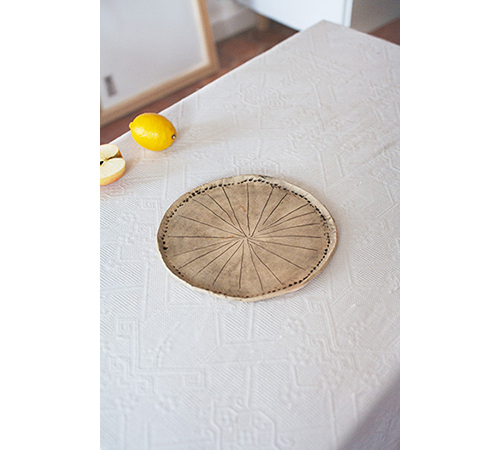
私はいくつもの「第一号」を発行しました。『パープル プローズ No.1』、『パープル フィクション(Purple Fiction) No.1』、『パープル ファッション(Purple Fashion) No.1』(初期)、『パープル No.1』、『エレン(Hélèn) No.1』、『パープル ジャーナル No.1』、『レ カイエ パープル No.1』 (笑)。一番長く続いたのが第13号まで発行された『パープル ジャーナル』で、オリヴィエとは『パープル』の第18号までともに携わりました。オリヴィエはその後一人でこの雑誌を続けていくことを決意し、題名も『パープル ファッション マガジン』に改めました。それが、今成功しているあの有名な雑誌です。私たちの方向性は異なっていたので、彼は私と一緒にいることで自分の思い描いていたものが作れなかったのだと思います。私が去った後、彼は自身の思うように変化をさせ、自分の道を歩み始めました。
I made a lot of 'No.1's' such as Purple Prose No.1, Purple Fiction No.1, Purple Fashion No.1 (the first period), and then Purple No.1, Helen No.1, Purple Journal No.1, Les Cahiers Purple No.1 (laughs). The longest I think was Purple Journal, which had 13 issues, and another was Purple for which I worked with Olivier on perhaps 18 issues.. Olivier decided to continue this himself, and changed the title to Purple Fashion Magazine that came to be very famous and successful. In a way I had kept him from doing what he wanted, as I was not going in the same direction as him. When I left, he changed things and went his own way.
エレン: こういう企画に携わると、印刷や流通といったさまざまなノウハウが身につきますよね。私たちは多くの展覧会の企画もやってきましたが、一貫して揺るぐことがなかったのは出版に対する興味です。これはオリヴィエにとっても同じことだと思っています。なぜかはわかりませんが、展覧会の企画は難しく感じるんです。でも、より大きな出版社を立ち上げれば良かったと思うことも時折あります。特にパープルに関してはそうです。私たちの周りにはマーク(ボスウィック)(NYを拠点に活動する写真家。90年代「パープル」や「アイ・ディー(i-D)」といった雑誌へのコントリビューションやマルタン・マルジェラとのコラボレーション・ブックやビデオの制作など、アート・ファッションの世界を行き来し、ファッション・フォトに大きな変革をもたらした)や、アンダース、ヴォルフガング・ティルマンス(ドイツ出身の写真家。『アイ・ディー』や『パープル』など、ファッション・カルチャー雑誌を通して世に知られることになった。2000年には、ドイツ人として初めてイギリスのターナー賞を受賞)や(ホンマ)タカシといった、よい写真家もいましたしね。
Elein: Yes when you do something like that, you also discover how everything works including distribution and printing. We also organized a lot of exhibitions. I supposed what has always stayed with me is publishing, and I think this is the same for Olivier. I don't know why, but I find it very difficult to organize exhibitions. But you know, sometimes I regret not building a big publishing company, which is what I realize with regards to Purple. We had all the good photographers around us like Mark (Borthwick), (Photographer based in NY. He has worked back and forth between world of art and fashion including the production of videos and a collaboration book with Martin Margiela, as well as contributing to magazines such as "Purple" and "i-D" in 90s. His work has brought about some major changes in the area of fashion photography), Anders, Wolfgang Tillmans (A photographer from Germany, known internationally for his work in fashion and culture magazine including "i-D" and "Purple.". In 2000, Tillmans was the first German photographer to win the British Turner Prize.), and (Homma) Takashi etc.
永井: ご両親は画廊をお持ちだと聞きましたが、今でも運営していらっしゃるんですか?
Nagai: I heard that your parents have an art gallery. Do they still run it?
エレン: ええ。父は80歳になったばかりですが、未だに毎日仕事をしています。彼の場合は特例で、完璧な仕事人間ですね。父はシュルレアリズムとダダ(ダダイズムは20世紀初頭、ヨーロッパのアヴァンギャルドから派生したアート・ムーブメント。第一次世界大戦に対する抵抗やそれによってもたらされた虚無を根底に持った思想が特徴)の専門家です。私はこのようなギャラリーシーンの中で育ち、いつもさまざまなアーティストと交流していました。私が若かった頃、父は大規模なフルクサス(1960年初めころからニューヨークを中心にケルン、コペンハーゲンなど欧米各地で展開された「ハプニング」、「イベント」といった身体表現を行ったグループ)の展覧会を企画し、そこでオノ・ヨーコ、ラ・モンテ・ヤング&マリアン・ザジーラがパフォーマンスをしていたのを覚えています。私が19歳か20歳くらいのときぐらいです。当時はいつも美術館や画廊に足を運んでいました。
Elein: Yes, my father is a special case because he just turned 80 years old but still works every day. He is fanatic when it comes to his work. He is a specialist in surrealism and dada(Dada was an art movement of the European avant-garde in the early 20th century, characterized by thoughts against established order and common sense).. So I did indeed grow up in this art gallery scene, always meeting different artists. Also when I was younger my father organized a large-scale fluxus(Groups that were established in the 1960s throughout the West including New York, Cologne, and Copenhagen. Their works have revolved around bodily expressions known as 'happenings' and 'events.) exhibition where Yoko Ono La Monte Young & Marian Zazeela came and did a performance. I was around 19 or 20 years old at the time. I was always going to museums and galleries back then.
また、父は一時期アンティーク・ディラーの仕事をしていました。そのときはジュークボックスを始めとした1950年代のアメリカのオブジェを専門に扱っていたので、私たちは頻繁にアメリカへと渡り、いくつもの広大なフリーマーケットや古道具店に足を運びました。父は兄と私に個人のコレクションを始めることを勧めました。そうでなければこういう場所だと飽きてしまうし、何かをコレクションしていれば、興味があるものを自分たちで探し出せると思ったんです。なので、私は子どもの頃からコレクションを持っていました。何を集めていたか知りたいですか?
My father was also at one point working more so as an antiques dealer specializing in 1950s American objects like jukeboxes. So we would go to the States very often and visit giant flea markets as well as many thrift stores. My father always encouraged my brother and I to collect things. He said that we would otherwise be bored in such a setting, but if we collected something then we could look for specific things of our interest. Therefore I had a collection when I was a child. Do you want to know what I collected?
永井: はい、もちろん!
Nagai: Yes, of course!
エレン: 私は子どもの頃、第二次世界大戦(1940年代)以前に作られたミッキーマウスのグッズを集めていました。ミッキーマウスは目の形が独特なのが印象的です。それはとても大きなコレクションへと発展しました。さまざまなオブジェを収集するアメリカ人のコレクターはたくさんいて、彼らが集う会に一度参加する機会もありました。私が集めていたのはとても具体的なものだったのですが、第二次世界大戦以前に製作されたミッキーマウスグッズに関しては、フランスで一番のコレクションを誇っていました。
Elein: When I was a child I collected Mickey Mouse items that were made before the Second World War, before the 1940s. You could recognize these items because Mickey Mouse's eyes were shaped differently. It became a big collection. As you know there are many American collectors who collect various items, and once I had been to meet these collectors. My collection was very specific, yet I had the largest collection in France of Mickey Mouse objects made before the Second World War.
永井: コレクションは現在も持っているんですか?
Nagai: Do you still have it?
エレン: いいえ、18歳くらいの頃にまとめて手放しました。14歳のときにはすでにコレクションを止めていて、その後アートコレクターに転換しました。アート作品を集め始めたのは17歳くらいの頃だったと思います。主にコンテンポラリーアートを集めていました。それもまた24歳か25歳のときに止めてしまいましたが、最終的に大きなコレクションになりました。いくつかの作品はまだ手元にあるんですが、働かずとも自分の独特なライフスタイルを維持すべく、コレクションのほとんどを売って生活資金に当てていましたね。
Elein: No, I sold it when I was about 18 years old. I think I had already stopped collecting when I was about 14 years old. Then I became an art collector. I started collecting art when I was around 17 years old. I was a contemporary art collector and stopped when I was around 24 or 25 years old or so, but I did indeed have quite a large collection. I still have a few things from this, but I sold a lot over the past years to finance my strange lifestyle without having to work.
永井: お父さまの影響は大きかったですか?
Nagai: So your father has been a large influence on you?
エレン: ある意味、そうですね。私にとってギャラリーで展覧会の企画に携わるのはとても自然なことです。慣れ親しんだ環境なんだと思います。
Elein: I suppose he has in a way. It is familiar for me to find myself in a gallery, installing exhibitions and such. It is a familiar setting.
永井: なるほど。僕も幼い頃からよく両親に連れられて美術館やギャラリーへ足を運んでいました。6歳の頃にアンディー・ゴールズワージー(スコットランド在住のアーティスト。石、氷、落ち葉、枝、土などを用いて、自然環境の中で場所の特異性を生かした彫刻を制作) の展覧会を観に行きました。そのときは自分が何を見ているのかが上手く理解できなかったんですが、大人になってから再び作品集の中で彼の作品と出会ったとき、当時の記憶が甦ったんです。僕は彼の作品が大好きで、この経験を今でも大切にしていますね。
Nagai: I see. My parents took me to museums and galleries as well from a young age. When I was 6 years old I saw an exhibition of works by Andy Goldsworthy (An artist whom lives and works in Scotland. Appropriating stones, ice, dead leaves, braches and, soil, he produces sculptures that makes use of the specificity of places within natural environments) . I didn't know what it was at that time, but later I saw the images again in a book and recognized them. I really liked his work. That experience has stayed with me.
エレン: 私の教育の一部でなかったのはやっぱり、文学や文章との関係性ですね。これらはだいぶ後になってから巡り会いました。私の父はとても視覚的な人で、彼の興味は常にアートにありました。両親は展覧会のカタログやアートに関する書籍以外は、あまり読書をするような人たちではなかったんです。私は後から映画や文学と出会い、自分がアートよりもそれらのジャンルにより興味があることに気づかされました。アートは私への教育の中で常に大きな役割をなしていましたが、私は違う道を追求する決心をしました。そうでなければ今もアート業界で活動していたと思います。しかし、私もオリヴィエも、アートのみの枠にとらわれたくはなかったんです。
Elein: What was not a part of my education is more the link with literature and text. This was something that I discovered much later. My father was a very visual person, and was very interested in art. My parents don't read much; only art catalogues and art text. I later discovered cinema and literature, and at one point I realized that I was more interested in literature and cinema than I was in visual art. Visual art was something that I naturally held close to my education, however I later decided to go in a different direction. Otherwise I would have stayed in the art world, but Olivier and I came to decide that we didn't really like being caught in the sole framework of the arts.
永井: 『パープル』がここまで世界的に広がった理由をご自分ではなんだと思いますか?
Nagai: What do you think is the reason for Purple being read so widely throughout the world?
エレン: 祐介さんが言う、「世界的に広まった『パープル』」とは『パープル ファッション マガジン』のことじゃないかしら?(笑)それ以前は特異な分野を取り上げつつも、幅広く流通していませんでした。もちろん、今でこそ世界中で読まれていますが、第1号の創刊当初から、インターナショナルな雑誌だったのかもしれないですね。他のアート紙とは異なっていました。
Elein: You know, I'm wondering if the Purple that you mention here as being widely read is in fact Purple Fashion Magazine (laughs). Before that it was not so widely distributed but was more precise. It's true that it was read worldwide. It was actually international from the offset even in the very first issue. This was not the case for other art magazines.
これには私の教育自体が常にインターナショナルであったことが要因しているかもしれません。私はいつも両親に同行してはさまざまなアーティストに出会いましたが、自分自身を特に「フランス人」として意識したことはありませんでした。オリヴィエは私よりフランス人気質なので、これは私に限ってのことなのかもしれませんね。1992年発行の第1号から、すでにさまざまな国や地域の方々に協力してもらっていました。それはとても自然なことだと思えましたね。だから(雑誌の)内容も自然と国際的になり、読者層もおのずとインターナショナルになりました。フランス人の著者による、フランスの芸術にまつわるアート紙を発行するのは、何の面白味もないと思ったんです。なので、意図的ではなく自然に広まっていったんだと感じていますね。
Perhaps it is because my education had always been very international. I had always travelled with my parents to visit different artists, but I had never really felt that 'French' in myself somehow. I think this is more on my side as Olivier is more French than I am. For me it was very natural from the very first issue in 1992 to have writers from different places contribute. Therefore, I feel that the content was naturally more cosmopolitan, and I think the readers were as well. If you make a French art magazine with French writers about French art, I don't think it is very interesting for international readers. So it was not a strategy, but it was something that came about very naturally.
これはウェブサイトを立ち上げた際に直面した一つの課題でもあったんですが、私にとって文学はとても大切な要素で、私自身もフランス語で書かれた文章のほうが向き合いやすいんです。ただ、フランス語のみの雑誌を発行するのにはいくらか抵抗がありました。例えば、イスラエルや日本の方にプロジェクトに参加してもらうことは私にとって不自然なことではないんです。文化や国の違いには目を向けず、文章そのものの内容や感覚を大切にしていました。ただ、ビジュアル的な要素(作品)に関しては、より国の違いが見受けられたかもしれないですね。これ(インターナショナルな要素)こそが、今までの活動の中で一貫したものだと思います。子どもの頃からアメリカ人のアーティストと頻繁に出会う機会もありましたし、また、マン・レイとも何度か家族ぐるみで旅行へ出かけました。
That was one of the issues I had when I started the website. Literature is very important to me and I work better with text when it is in French, but I really could not work on something that was written entirely in French. It wasn't strange for me to ask someone from Israel or from Japan to contribute something because I don't focus on differences in cultural or geographical frontiers. Instead, I tend more to notice the sensibilities and characteristics of the text. This (international element) I suppose is what I always kept in my mind. I was always with American artists as a child, and I also had met Man Ray several times and we went on family holidays together.
永井: やっぱり、ユン・キットさんとの出会いがインターネットを通したものであったことが興味深いですね。
Nagai: I again think it is interesting how you found Jun Kit through the Internet.
エレン: そうですね。何の躊躇もなく、今回のプロジェクトに声を掛けさせてもらいました。アート業界ではあり得ないことですよね。遠い国で暮らし、ましてや、一度も会ったことのない赤の他人に普通こんなお願いはしません。人はある特定の業界と範囲の中でのみ、繋がりを見出すんだと思います。今回の書籍に掲載されているアルゼンチン出身の方たちとは、10年ほど一緒に仕事をしていますが、一度も直接お会いしたことはないですね。
Elein: Yes, and I wasn't afraid to ask him to contribute. I noticed that no one would do this in the art world. No one would ask a complete stranger in a country far away whom they've never met, to do something like this. I think people connect with a specific world and a specific code. There are some people that I have never met for instance, the Argentinian contributors whom I have now been working with for over 10 years.
以前『パープル』では掲載を希望する写真家たちから多くの作品が届いていました。それはものすごく膨大な数でした。それでも、私たちは全ての作品に目を通しては、若い人やさまざまな国の作家にためらいもなく声をかけました。アミット・バーロウィッツは私がパリに住んでいたときに会いに来てくれたのですが、彼女とはカフェで待ち合わせたのを覚えています。ただ、そのうちに掲載を希望する作家がさらに増え続けたため、あるときから全ての作品を見ることができなくなりました。もちろん、今の状況は違います。私はこの特殊な環境に自分からいなくなったので、今ではそれほど多くの方に連絡をもらうこともなくなりました。
At Purple we were also receiving a lot of works from photographers who wanted to be in Purple, but at one point it became too much. However we did look at everything and we didn't hesitate to ask people really young, or people from a completely different place. In the case of Amit Berlowitz, she came to see me once when I lived in Paris and we met in a cafe. I have to say, that at one point there was so much demand that I wasn't able to look at submissions anymore. Now the case is different of course. I don't get many people contacting me as I've somewhat detached myself from this specific scene.
永井: エレンが『パープル』を発行してそれが世界中へと広まった。ユン・キットさんがマレーシアでそれを読み、自身のブログで取り上げた。そのブログをまた、あなたがご覧になった。そのような経緯で改めて読者との繋がりを見出すんですね。これはとても面白いコンセプトだと思います。今回の新たなプロジェクトでもまた、インターネットを通じてさまざまな人たちと出会ったんですね。
Nagai: So through publishing Purple it became widely distributed throughout the world, Jun Kit read it in his country and then did something on his blog which you saw, and in such a way you reconnected to the readers of Purple. I think that this is an interesting concept. Again, for this new project you connected with different people through the Internet.
エレン: ネットを使うことにいくつかの利点があったことは確かですが、やっぱりそこにはある種の「軽さ」が存在します。ネットでは分け隔てなく誰でも好きなことを掲載することが可能なので、紙媒体に印刷したものに比べるとどうしてもクオリティーが下がってしまうと思います。インターネットで一番惹かれるのは、全く経費がかからないということでした。お金がかからないということが、私をとても安心させました。今のご時世、出版資金を集めるのはとても難しいんです。これは課題の一つとして、私を大いに悩ませてきましたね。
Elein: There were some good things about it in fact, but in a way it was 'lighter.' In general the quality of things on the Internet are not as good as that on paper because of its nature that allows anyone and anything to be published. One thing I really liked a lot at first is again, the fact that I did not need to look for money. It was free, and that was a big relief. It's very hard to find money to publish these days, and this factor has always weighted heavily on me.
私たちはあたかも成功しているように思われがちですが、二人ともビジネスが苦手だったんです。苦労は耐えませんでしたね。たとえ資金調達に成功したとしても、ページ数を増やしたりカラーにしたりとさまざまな要望が増えていくので、出費はさらにかさみました。ある種の悪循環でしたね。オリヴィエはその後もページ数やコンテンツを増やす方向で進めていきました。『パープル ファッション マガジン』の発行には膨大な経費がかかりますが、彼は多くの資金を調達するのに成功したみたいです。
People think we were successful, but perhaps we were not very good business people. It was always a struggle. It is a vicious circle because even if we succeed and gain funds, there is again the desire to print more pages, and the inclusion of content in color that is ultimately rather expensive. I think Olivier continued in this manner, of increasing the number of pages and content. I think the printing of Purple Fashion Magazine was going to be very expensive, but I think he was able to raise an enormous amount of money.
ですが、オリヴィエは現在も同じ状況下にいます。よりたくさんの資金を注いでも、システム自体は当初と変わらないんです。私たちはコンサルティング業務といった副業を常に行っていたんですが、彼はさらに大きなスケールでそれに取り組んでいました。こういった副業を私は好みませんでした。自分のクリエイティビティを多くの人に売り渡すということは、何かしらの突発性やひらめきを失うことになると思うんです。だからこそ、10年以上広告や編集の仕事に携わった写真家たちの作品は、その面白味が薄れてきます。質問の主旨から少し話しが逸れてしまいましたね。
However, he is still in the same situation. He spends more money, but it is the same system as when we started. We would always have another job on the side such as consulting, which he just does on a bigger scale than I do. I didn't like doing these jobs on the side. I think in a way if you sell your creativity to many others you tend to lose your spontaneity and spark. This is why that in general for photographers who after 10 years or so of doing a lot of advertising and editorial jobs, their work becomes less interesting. I think I've strayed away from your question a little bit perhaps.
永井: 最後の質問となりますが、このプロジェクトの次に何をされる予定ですか?
Nagai: Now for the final question, what do you plan to do after this project?
エレン: 小さなアート・プロジェクトを一つ控えています。新たに暮らし始めた村で最近ひとりのアーティストと出会ったんですが、彼女もまたパリやブリュッセルで生活をした後、私と同じような考えを持って地方へと移住したんです。彼女の家は周囲に何もない大自然の中に建っていますが、その家の室内にディスプレイを作ってほしいと依頼されました。私の家も小さな店舗スペースに隣接しているので、今後二人でこのプロジェクトを追求していこうと思っています。私は多分、写真関係のディスプレイを作ることになると思います。この企画は6月からスタートする予定だったんですが、私自身今回の(レ クロニーク パープル)プロジェクトで忙しかったので、 実際は7月に先延ばしになりそうです。私たちは一年を通して毎月新しいディスプレイを製作していきます。これはどちらかというと、とても個人的なプロジェクトになると思いますね。
Elein: I have a small art project. I recently met an artist in the place where I live. She also used to live in Paris and Brussels, and had then moved to the country in a similar spirit of mine. She proposed to me that we do a vitrine in her house that is completely remote in the middle of nowhere. In my house in my village I also have a little storefront, so we are going to work together on this. I suppose I will work with photography. In fact, we were supposed to start in June but because I have been very busy with this current project, I think we are going to postpone it to July. Over the course of one year, we are going to do a different vitrine each month. I suppose this will be a more personal project.
もう一つ視野に入れていることは、土地を購入して自分の家を建てることです。ただ、これは先になるかもしれません。ここ最近、18世紀の中国を生きた知識人や文豪に関する本を読んでいましたが、彼らは作家であると同時に庭仕事をしていたらしいんです。私が土地と家の購入をある種のプロジェクトとして捉えているのも、私個人が彼らの生き方に共感しているからです。私の生活は、文章の執筆、友人たちと過ごす時間、お料理する時間、自然野菜を収穫するひととき、庭作業で成り立っています。私はこれらのことをとても大事にしています。現在地方の村で暮らしていますが、家にはお庭がなく、前に植木を数個並べている程度です。今はまだ私にとって移行のときなんです。将来的には村を出て大自然の中で生活したいと考えていますね。
My other project is to buy a plot of land and have my house built, but perhaps this will not be so soon. I also consider this to be like a project in a way because recently I have read some things about Chinese intellectuals and literates in the 18th century, who were writers but were also tending their gardens. I think very close to this. I see my life writing and being around friends, cooking, picking wild vegetables, and tending a garden. This is something that is important to me. For now I do live in the country, but in the village I don't have a garden. I just have a little place to keep a few pots outside my home. So I think I am still in a transition, and the future will be to leave the village and to have the natural landscape all around me.
永井: それは素晴らしいですね。
Nagai: That's wonderful.
エレン: 今の暮らしは以前と大きく変わりません。より静かで小規模な生活ですが、所詮村という環境です 。私の村には映画館まであります。そこはちょっとアートな雰囲気の映画館で、時折面白い作品を上映しています。ジム・ジャームッシュのほか、中国の若手映画監督の作品なども上映されています。地方暮らしを希望しつつも自然に関する知識が全くと言っていいほどなかった私にとって、このような環境に巡り会えたのは奇跡でした。また、新しく生活を始めた村で、サンフランシスコの「シティライトブックストア(City Lights Bookstore) 」(サンフランシスコ・ノースビーチにある詩人ローレンス・ファーリンゲッティが設立した老舗書店であり、ビートカルチャー発祥の本屋)の店主を勤めていた方とお会いしたのも不思議なご縁です。こういう村はフランスでは他にあまりないと思うので、とてもラッキーでした。そうでなければ、村といえば静かで何もない場所になりがちです。もしこの村の住民が全員フランス人であったとしたら、私もなかなかここでの生活に馴染むことができなかったでしょう。なぜなら、私自身フランス人のみのコミュニティーで暮らしたことがなかったからです。私の住む村の住民のほとんどが外国人で、誰しもが偏見を持っていないのです。
Elein: For the moment my life is not completely different. It's much more quite and on a smaller scale, but I am nonetheless still in a village. There is even a cinema in my village, which a kind of arty cinema where they have some very good films. I know they play Jim Jarmusch and some works by contemporary Chinese filmmakers. This is miracle because I wanted to live in the country, but at the same time I didn't know anything about it. The fact that I arrived in a village and encountered someone who used to run the City Lights Bookstore in San Francisco is really strange. I don't think there are many villages like this in France, so I was incredibly lucky. Otherwise a village could be really dead and quiet. If there were only French people living there I would have felt very strange because I am not used to living in a solely French community. In my village, most people are foreigners and they are very open-minded.
Les Chroniques Purple
言語:英語、日本語(日本版のみ日本語訳冊子付)
サイズ:A4 変形(210×279mm)
ページ:本誌264ページ、日本語訳冊子64ページ
制作:VACANT、 Les Editions Purple
発行元:VACANT(Fat Love Co. Ltd.)
編集長:エレン・フライス
AD:エレン・フライス、永井祐介(VACANT/NO IDEA)
デザイン:須山悠里
価格:¥2,900(税抜)
『Les Chroniques Purple』巡回展
会場:Center for COSMIC WONDER Osaka
住所:大阪市西区新町1-13-17
会期:6月6日(金)~ 22日(日)
休館日:11日(水)、18日(水)
開館:12:00~20:00
入場料:Donation
取り扱い店舗
岩手
APARTMENT
東京
青山ブックセンター本店
青山ブックセンター六本木店
BEAMS T
百年
IMA CONCEPT STORE
NADiff a/p/a/r/t
PARCO BOOK CENTER
SHELF
東塔堂
SHIBUYA PUBLISHING BOOKSELLERS
DAIKANYAMA TSUTAYA
TSUTAYA TOKYO ROPPONGI
UTRECHT
愛知
ON READING
京都
恵文社
YUY BOOKS
大阪
ATHENS
BOOK OF DAYS
MARUZEN&ジュンク堂書店 梅田店
愛媛
螺旋
オンラインショップ
CMBMC

